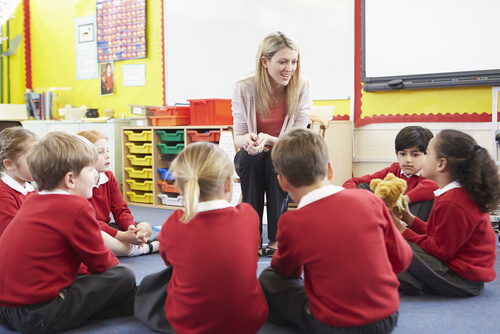
Table of contents
There are some big differences between nursery and Reception class in primary school. It is useful to find out how life will change for your child when they leave nursery and start school.
Also referred to as Year R, Year 0 or Primary One, depending on where in the UK you live, Reception is the first year of primary education. It is the final year of the Early Years Foundation Stage and the gateway to Key Stage 1, kicking off a child’s formal education.
Although a significant milestone, the transition from nursery to primary school can feel daunting for both you and your child. Being prepared for the changes to come will help you to overcome any obstacles you might face.
What are the key differences between Nursery and Reception?
| Nursery | Reception | |
|---|---|---|
| Age Range | 6 months to 4 years old | 4–5 years old |
| Setting | Standalone or attached to schools | Primary Schools (formal setting) |
| Curriculum | Children follow an early years curriculum based very much on learning through play (different curriculum in each UK country) | Children will also follow an early years curriculum in Reception but the learning although containing some play is more formal and structured |
| Hours | Flexible (part-time/full-time) | Full-time |
| Staff Qualifications | Nursery staff, practitioners | Qualified teachers and teaching assistants |
| Main Goal | Social and emotional development | Transition to formal learning |
This article will cover some of the main differences between nursery and reception. It also hopefully offers some reassurance that the step up really isn’t as big as it might seem.
Longer hours in Reception
The flexibility offered by nurseries means that children often attend on a sessional basis. These are either in the morning or the afternoon, usually for around three or four hours at a time. Even for children who do attend for the full day, they’re likely doing this two or three times a week rather than every day.
This means that the Monday-Friday, 9am-3pm (or thereabouts) routine of school life can be quite an adjustment for children.
To help with the transition, most schools will incorporate a settling in period. Children will do half days and work their way up to a full school day over a few weeks. This helps them to get used to the balance of school time and home time. With any luck, the fun that they have during this staggered period will mean they’ll barely recognise the additional time spent at school.
To help adjust to longer hours, many schools also account for children’s energy levels lagging as the day goes on and incorporate things like story time at the end of the day to give children the opportunity to sit quietly and replenish some energy.
Different routines
As well as the longer hours, the whole routine of school life can be quite different to nursery.
Many aspects of nursery routines are child-led and allow children to decide how they spend large portions of their day. In reception class, routines are typically arranged to mirror the rest of the school. Children will need to fit into a more structured routine where things like breaktime and learning time are scheduled.
With that being said, reception class does generally offer more flexibility than Year 1 and upwards. This allows children space and time to get used to the structure of the school day.
If this is something you’re worried about, remember that having a routine is no bad thing. Once children become accustomed to what they can expect from the school day, they’re likely to feel more comfortable and secure whilst there. Even on the hardest of days, they’ll know that home time is just around the corner.
Bigger class sizes in Reception
Generally speaking, the average reception class size includes around 10 more children than the average nursery class. They are limited to a maximum of 30 children per class.
This will of course differ depending on the specific school your child is attending. Some schools in villages or remote areas having a much smaller intake.
If you think your child may struggle with a bigger group, it could be a good idea to take them to things like play groups during the summer leading up to them starting reception. This will give them the opportunity to mix with a larger number of children who they may not have met before. Hopefully this will make those first few days less intimidating for them.
Many schools also offer taster days, where children can go to school for a couple of hours, accompanied by you, and get to know their teacher as well as the other children who will be in their class.

More structured learning in school
Through child-led experiences, nurseries often have a heavy focus on learning through play. Although reception will continue to incorporate play as a tool for development, there’ll likely be more adult-led activities as your child is introduced to the final stages of the EYFS curriculum if they are in England. Children in Scotland, Wales and Northern Ireland follow different curriculums.
A typical school day will include sessions dedicated to a specific subject, such as literacy or maths. Children will be guided through activities suited to their stage of development. Although the sessions will be designed to be engaging and fun, children will be expected to focus their attention. They won’t have the option to choose something else to do, like they might have done in nursery.
Reception is also usually the time when homework is introduced. Whilst it should be fairly limited at this point, it’s a whole new thing for children to get used to. Who actually wants to take work home with them after all?
If possible, try to sit down to do homework shortly after you get home from school. This will get children into a good routine and they’ll know that the sooner they get it done, the more time they’ll have to themselves, also setting them up well for the future.
Higher expectations at school
Growing up inevitably comes with higher expectations. As children settle into their routine, they’ll be expected to follow the rules and fit in with the culture of their school. Teachers will encourage them to be the best that they can be. They’ll also learn more about the consequences of their actions as they become more independent.
Although all the additional rules can seem limiting in some ways, reception will set the tone for the rest of your child’s learning journey. High expectations will promote their own self-esteem, building the foundations of the confidence and self-belief that will see them through all the trials and tribulations that school life has to offer.


